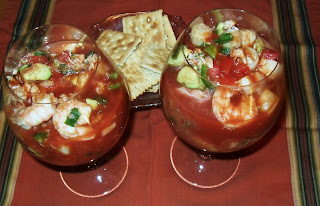
Having grown up in Southern California, and before I went to Mexico the first time at age 15, I thought
guacamole was dip. My mother made it with mayonnaise (or more likely Miracle Whip) and our next door neighbor made it with sour cream. You could buy it in little tubs from the grocery store which actually called it "guacamole dip" and the only thing similar to the real thing may have been the color. Some of it was awful.
On my first trip to Mexico at age 15, I was sent to live with a family in Guadalajara. Every day around 2PM we ate a large meal -
la comida - with the family at a long dining room table. There were four American students, three of teen-aged their children, and the father that always sat with us to eat each day. The mother, Doña Meche (short for Mercedes), never joined us as she served the meal course by course and plate by plate each day to each one of us. We always started with a soup, then moved to a vegetable dish served on a separate plate, then a main course followed by dessert, which was always something very simply.
One thing that was always on the table was real
guacamole. Todos los días. She mixed avocados with chopped tomato, onions, and cilantro, then seasoned it with salt and some lime juice, and that was all - no mayonnaise, no sour cream. It was delicious!
Muy delicioso. Also in the middle of the table every day was a bread basket with
bolillos, tostadas and saladitas (saltine crackers) so that we could eat our
guacamole with any one of those, or wait for the hot corn tortillas that were served with the meal and eat little
guacamole tacos. Every home I have stayed in since, and every time we have visited Mexico - be it to a restaurant or to my mother-in-law's home - we have been served a similar
guacamole, although most of the places that weren't catering to young American students always add a chopped serrano pepper to the mix to spice it up. I have had creamy
guacamoles, and some very chunky
guacamoles served with large pieces of avocado, tomatoes, serranos, cilantro and onions just barely tossed together with seasonings. I have bought
aguacates (avocados) in the marketplace by the kilo, and I hate to tell you that sometimes one kilo of avocados cost me less than one single avocado costs here in the winter.
One of the best
guacamoles we ever had on a trip with our kids was one that was served in Guaymas, Sonora. It was the usual variety of avocado, tomatoes, peppers, onions and seasonings mixed with crumbled
queso fresco. (See today's picture) Another one that was memorable was one served to me in Monterrey, Mexico on a platter. To one side of the platter was smoothly mounded mashed avocado, and around the avocado were little piles of diced tomatoes, onions, peppers, cilantro, and cut-up limes. This made it possible to mix your own guacamole at the table to your personal taste.
A number of Mexican restaurants are now featuring
guacamole which is mixed table-side by a waiter performing a routine. Since the charge for this
guacamole can be $10 or more, you are paying for the show - believe me. A good
guacamole should be (and still is) one of the most economical and satisfying accompaniments and/or light meal choices you can make, and goes well with so many Mexican meals.
































